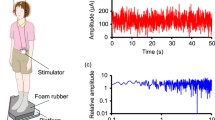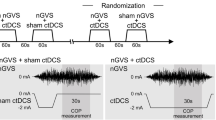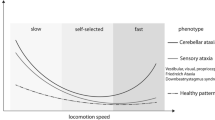Abstract
Through the cerebellar vermis, the vestibular nerves are known to influence the basal ganglia and the limbic system. By means of noisy galvanic vestibular stimulation (GVS), it may be possible to ameliorate movement disorders, particularly akinesic symptoms, in patients with central neurodegenerative disorders. We evaluated the effect of 24-hour noisy GVS on a power-law temporal autocorrelation exponent of daytime wrist activity, separately for higher (local maxima) and lower (local minima) levels of activity, in 14 hospitalized patients. The power-law exponent for the local maxima was significantly (p < 0.002) lower with the noisy GVS than with sham stimulation, suggestive of more frequent switching behavior from low to high levels of activity or less severe akinesia. The noisy GVS may thus potentially improve certain motor dysfunctions in patients with distinct central neurodegenerative diseases.
Similar content being viewed by others
References
Albert TJ, Dempesy CW, Sorenson CA (1985) Anterior cerebellar vermal stimulation: effect on behavior and basal forebrain neurochemistry in rat. Biol Psychiat 20:1267–1276
Anderson CM, Polcari A, Lowen SB, Renshaw PF, Teicher MH (2002) Effects of methylphenidate on functional magnetic resonance relaxometry of the cerebellar vermis in boys with ADHD. Am J Psychiat 159:1322–1328
Barmack NH (2003) Central vestibular system: vestibular nuclei and posterior cerebellum. Brain Res Bull 60:511–541
Chaudhuri A, Behan PO (2000) Fatigue and basal ganglia. J Neurol Sci 179:34–42
Collins JJ, Imhoff TT, Grigg P (1996) Noise-enhanced information transmission in rat SA1 cutaneous mechanoreceptors via aperiodic stochastic resonance. J Neurophysiol 76:642–645
Fitzpatrick RC, Day BL (2004) Probing the human vestibular system with galvanic stimulation. J Appl Physiol 96:2301–2316
George MS, Sackeim HA, Rush AJ, Marangell LB, Nahas Z, Husain MM, Lisanby S, Burt T, Goldman J, Ballenger JC (2000) Vagus nerve stimulation: a new tool for brain research and therapy. Biol Psychiat 47:287–295
Moss F, Ward LM, Sannita WG (2004) Stochastic resonance and sensory information processing: a tutorial and review of application. Clin Neurophysiol 115:267–281
Newlands SD, Perachio AA (2003) Central projections of the vestibular nerve: a review and single fiber study in the Mongolian gerbil. Brain Res Bull 60:475–495
Ohashi K, Nunes Amaral LA, Natelson BH, Yamamoto Y (2003) Asymmetrical singularities in real-world signals. Phys Rev E 68:065204
Pan W, Ohashi K, Yamamoto Y, Kwak S (2007) Power-law temporal autocorrelation of activity reflects severity of parkinsonism. Mov Disord 22:1308–1313
Rush AJ, George MS, Sackeim HA, Marangell LB, Husain MM, Giller C, Nahas Z, Haines S, Simpson RK Jr, Goodman R (2000) Vagus nerve stimulation (VNS) for treatment-resistant depressions: a multicenter study. Biol Psychiat 47:276–286
Rutecki P (1990) Anatomical, physiological, and theoretical basis for the antiepileptic effect of vagus nerve stimulation. Epilepsia 31(Suppl 2):S1–S6
Soma R, Nozaki D, Kwak S, Yamamoto Y (2003) 1/f noise outperforms white noise in sensitizing baroreflex function in the human brain. Phys Rev Lett 91:078101
Teicher MH (1995) Actigraphy and motion analysis: new tools for psychiatry. Harvard Rev Psychiat 3:18–35
Wiesenfeld K, Moss F (1995) Stochastic resonance and the benefits of noise: from ice ages to crayfish and SQUIDs. Nature 373:33–36
Yamamoto Y, Struzik ZR, Soma R, Ohashi K, Kwak S (2005) Noisy vestibular stimulation improves autonomic and motor responsiveness in central neurodegenerative disorders. Ann Neurol 58:175–181
Author information
Authors and Affiliations
Corresponding author
Rights and permissions
About this article
Cite this article
Pan, W., Soma, R., Kwak, S. et al. Improvement of motor functions by noisy vestibular stimulation in central neurodegenerative disorders. J Neurol 255, 1657–1661 (2008). https://doi.org/10.1007/s00415-008-0950-3
Received:
Revised:
Accepted:
Published:
Issue Date:
DOI: https://doi.org/10.1007/s00415-008-0950-3




